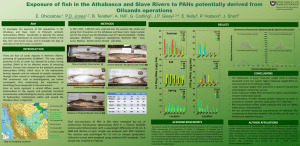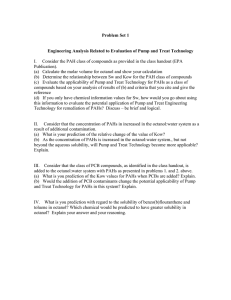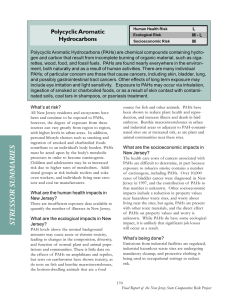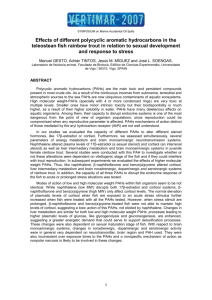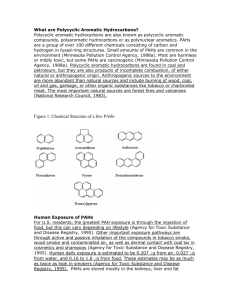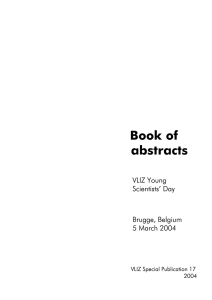Polycyclic aromatic hydrocarbon (PAH) emissions from a coal-fired pilot FBC system
advertisement
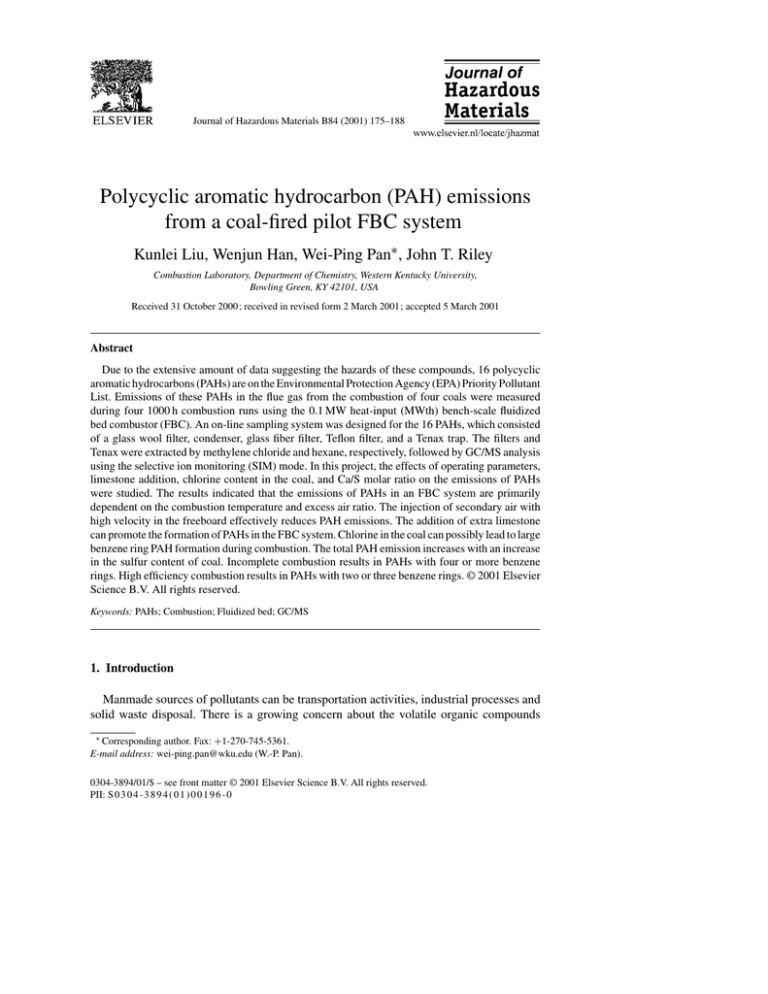
Journal of Hazardous Materials B84 (2001) 175–188 Polycyclic aromatic hydrocarbon (PAH) emissions from a coal-fired pilot FBC system Kunlei Liu, Wenjun Han, Wei-Ping Pan∗ , John T. Riley Combustion Laboratory, Department of Chemistry, Western Kentucky University, Bowling Green, KY 42101, USA Received 31 October 2000; received in revised form 2 March 2001; accepted 5 March 2001 Abstract Due to the extensive amount of data suggesting the hazards of these compounds, 16 polycyclic aromatic hydrocarbons (PAHs) are on the Environmental Protection Agency (EPA) Priority Pollutant List. Emissions of these PAHs in the flue gas from the combustion of four coals were measured during four 1000 h combustion runs using the 0.1 MW heat-input (MWth) bench-scale fluidized bed combustor (FBC). An on-line sampling system was designed for the 16 PAHs, which consisted of a glass wool filter, condenser, glass fiber filter, Teflon filter, and a Tenax trap. The filters and Tenax were extracted by methylene chloride and hexane, respectively, followed by GC/MS analysis using the selective ion monitoring (SIM) mode. In this project, the effects of operating parameters, limestone addition, chlorine content in the coal, and Ca/S molar ratio on the emissions of PAHs were studied. The results indicated that the emissions of PAHs in an FBC system are primarily dependent on the combustion temperature and excess air ratio. The injection of secondary air with high velocity in the freeboard effectively reduces PAH emissions. The addition of extra limestone can promote the formation of PAHs in the FBC system. Chlorine in the coal can possibly lead to large benzene ring PAH formation during combustion. The total PAH emission increases with an increase in the sulfur content of coal. Incomplete combustion results in PAHs with four or more benzene rings. High efficiency combustion results in PAHs with two or three benzene rings. © 2001 Elsevier Science B.V. All rights reserved. Keywords: PAHs; Combustion; Fluidized bed; GC/MS 1. Introduction Manmade sources of pollutants can be transportation activities, industrial processes and solid waste disposal. There is a growing concern about the volatile organic compounds ∗ Corresponding author. Fax: +1-270-745-5361. E-mail address: wei-ping.pan@wku.edu (W.-P. Pan). 0304-3894/01/$ – see front matter © 2001 Elsevier Science B.V. All rights reserved. PII: S 0 3 0 4 - 3 8 9 4 ( 0 1 ) 0 0 1 9 6 - 0 176 K. Liu et al. / Journal of Hazardous Materials B84 (2001) 175–188 (VOC) or semi-volatile organic compounds (SVOC) generated in coal combustion. Some of these compounds, polycyclic aromatic hydrocarbons (PAHs) have generated considerable interest because of their hazardous effects. Concerning the emission of PAHs, several of these compounds are known carcinogens and/or mutagens that are hazardous to human health. These environmental concerns have motivated regulatory agencies around the world, such as the US Environmental Protection Agency (EPA), to pass legislative restrictions over the release of PAHs into our environment, especially for 16 PAHs [1]. Theoretically, organic compounds may be formed and/or released during the inefficient combustion of any fuel containing carbon and hydrogen. There are many organic materials which have chemical structures that are able to form PAHs under pyrolysis and combustion processes [2–6]. PAHs undergo a series of reactions during combustion such as breakdown reactions, cyclization reactions and oxidation reactions. At 800–950◦ C during fluidized bed combustor (FBC) combustion, the destruction and chemical alteration of PAHs are possible in the presence of oxidants such as HO• , O3 , and HNO3 , etc. [7]. Efficient pyrolysis of coal should result in the breakdown of large organic molecules to smaller hydrocarbons and in efficient combustion the only products should be CO2 and H2 O. However, such complete degradation of coal rarely occurs and fairly large organic compounds, including PAHs, can be released from combustion sources. So, the formation of PAHs during coal combustion follows a complex pathway. Their formation depends on many variables such as temperature, oxygen ratio, and carbon-to-hydrogen ratio of the fuel. The most common sampling methods for PAHs use either filters or adsorbents or a combination of both. Glass fiber filters are often used since they allow high flow rates. However, collection of PAH samples on filters alone is not accurate because even some low volatile PAHs experience significant volatility losses during long collection time on filters. The adsorption of individual PAH compounds by filters and adsorbents varies greatly [8]. For example, 100% of the benzo[ghi]perylene detected was retained by the filter and none with the adsorbents. Only about 20% of the pyrene and fluoranthene was captured by the filters, while the rest was associated with the adsorbents. Compounds such as naphthalene and phenanthrene were almost entirely captured by the adsorbents. Because the concentrations of PAHs in the flue gas of FBC systems are usually very low, even below the microgram per cubic meter level, very sensitive and selective analysis methods are needed. To achieve the required sensitivity level, preconcentration of the sample is necessary before analysis by conventional instrumental methods. The aim of this work was to evaluate a useful sampling and measuring procedure and to study how fuel and operating combustion variables affect the emission and the distribution of PAHs in the sampling materials during coal combustion. 2. Experimental 2.1. Combustion facility The 1000 h experiments were carried out with a bench scale fluidized bed combustor, which has a 0.3 m i.d. and 4.4 m effective height. A schematic diagram of the system is shown in Fig. 1. The bench-scale 0.1 MWth FBC at Western Kentucky University (WKU) K. Liu et al. / Journal of Hazardous Materials B84 (2001) 175–188 177 178 K. Liu et al. / Journal of Hazardous Materials B84 (2001) 175–188 was designed to serve as a flexible research and development facility to evaluate combustion performance, and to estimate the effects of flue gas emissions. During tests, limestone and coal were auger-fed into the combustor under positive pressure at a port 0.1 m above the air distributor; the feed rate of coal and limestone were controlled separately. Six moveable heat exchange tubes were added in the bed area of the atmospheric fluidized bed combustion (AFBC) system. Typical operation of the combustor involves setting the correct fuel/limestone feed and air flows and then use the moveable heat exchange tubes to adjust the bed temperature to the desired setting. Another 66 gas heat exchange tubes are in a fixed position located approximately 1 m from the top of the combustor. The hot gases from the combustor are allowed to enter a wet cyclone scrubber where they are met with a wall of water (which keeps the cyclone cool), which subsequently takes solids from the cyclone into a holding tank. The operating parameters (air flow, water flow, coal/lime feed, bunker weight, temperatures, and pressure) are controlled and logged to file with a computer. The analytical data for the four coals used are given in Table 1. Since 1997, the FBC facility was modified by installing two sets of secondary air nozzles. The first set of secondary air ports, fitted with two nozzles, is 1.6 m above the setter plate and the second set is 0.6 m above the first one. Forced air, at a calculated ratio, from the high pressure blower is injected tangentially at an angle of 30◦ into the freeboard through secondary air nozzles. This air forms a strong vortex flow above the nozzles. Under this tangential flow, particles escaping from the fluidized bed are separated from the flow. The large particles fall back into the bed along the wall, while the small particles form a suspended layer to prolong their residence time in the combustor. A Shimadzu GC-8A was used to continuously monitor the concentration of oxygen, carbon monoxide and carbon dioxide in the flue gas during the combustion run. Measurement Table 1 Analytical valuesa for the coals used in the study 98011 98111 99426 99626 Proximate analysis (%) Moisture Ash Volatile matter Fixed carbon 10.63 10.10 34.03 55.87 10.25 9.67 34.84 55.49 2.33 8.70 36.98 54.32 6.96 13.81 34.14 52.05 Ultimate analysis (%) Ash Carbon Hydrogen Nitrogen Sulfur Oxygen 10.10 75.59 4.52 1.51 1.09 6.73 9.67 74.18 4.73 1.59 1.68 7.72 8.70 76.25 4.89 1.79 0.97 7.37 13.81 69.53 4.49 1.55 4.48 5.73 Miscellaneous analysis Chlorine (ppm) Fluorine (ppm) Btu (lb) a 4720 13017 4199 94 13226 Moisture is as-received, all other values are reported on a dry basis. 261 168 13655 4084 131 12406 K. Liu et al. / Journal of Hazardous Materials B84 (2001) 175–188 179 results were used to adjust the coal and limestone feeding rate and combustion air flow rate. 2.2. Sampling system To determine if any PAHs were formed in flue gas during the combustion reactions, the PAHs were collected at 0.6 m from the top of the combustor. The temperature of flue gas at the sampling port is around 650–700◦ C. The trapping line consisted of the following components: • A glass wool filter to remove the particles in the flue gas. • A condenser to remove the water in the flue gas to avoid any water absorption by Tenax. • A trapping device containing a Teflon filter (2.0 m, 37 mm diameter), Tenax, and glass fiber filter (1.0 m, 37 mm diameter). The Tenax and filters must be kept at 150◦ C prior to test for 1 h to remove any contamination of organics. The sampling time for each PAH sample was around 24 h of steady-state operation with 2.5 l/min flow rate of the flue gas following 4 h for equilibration after beginning a new condition. In order to avoid any condensation of PAHs with high boiling points, the temperature of the glass wool filter was kept at about 400◦ C using insulation material. The PAH samples collected by filters and Tenax were kept in the refrigerator at 4◦ C and protected from sunlight until extraction. Hexane was chosen as the extraction solvent for Tenax while methylene chloride was used for the filters and condenser, since methylene chloride reacts with Tenax during the extraction process. The Teflon filter and glass fiber filter were extracted together. The temperatures of the extraction were 110◦ C for methylene chloride and 130◦ C for hexane. Then, the extracts were concentrated to below 1 ml before GC/MS analysis and the volumes of the extracts were measured using graduated vials. During the analysis process, five samples were doped with a known amount of deuterated PAH compounds (Naphthalene-d8, Anthracence-d10 and Benz[a]anthracene-d12) before extraction to determine the recovery rate for the analysis process. A 95.1% recovery rate was achieved for the study. Meanwhile, at the beginning of this study, the same sample was extracted, concentrated and analyzed under the same conditions three times to determine the analysis system errors. The results indicate that the error range in this study is ±5%. The analysis was performed with a Shimadzu QP-5000 GC/MS system with a NIST/ EPA/NIH 62000 compound database. Approximately 30 different PAH compounds were identified with the GC/MS through the NIST library database search. However, 16 US EPA-specified PAHs were the focus of this study. The mass spectrometer was operated in two modes. One was the scan mode for determining the retention time of each of the 16 PAHs; the other was selected ion monitoring (SIM) mode for the analysis of the samples of PAHs. The identification of compounds was accomplished by comparing the retention time of the samples to the retention time of PAH standards run under the same conditions and the corresponding mass spectra. The quantitative analysis was carried out using the calibration data of the PAH standard which contains the 16 PAHs specified by EPA. The detection limits for these 16 PAHs using the GC/MS SIM mode are 1–10 ppb, depending on the boiling point of the individual PAHs. 180 K. Liu et al. / Journal of Hazardous Materials B84 (2001) 175–188 3. Results and discussion At the beginning of this study, the distribution of PAHs along the sampling line was conducted under a certain operating condition. Table 2 shows representative results obtained from the coal 98011 run. The glass wool filter, condenser, Teflon and glass fiber filters, and Tenax were extracted separately. None of the 16 PAHs were found in the glass wool filter, possibly due to the high temperature (400◦ C) kept for the filter. The main purpose the of glass wool filter is to collect ulate and only let particle-free flue gas go through the PAHs trapping line. The combustion conditions for the test were temperature at 790◦ C; static bed height at 700 mm; fluidizing velocity at 1.26 m/s; and excess air ratio at 1.34. From Table 2, one can clearly see that the amount of PAHs existing in the flue gas during coal combustion was very small and almost all the PAHs were collected by the fiber filters and Tenax. Only a very small amount (∼5%) of the PAHs condensed in the condenser. Meanwhile, the PAHs were distributed randomly in the fiber filters and Tenax. The filters seem to trap more of the larger PAHs than did the Tenax. This result may be due to the trap having a sandwich arrangement. The Teflon filter was put before Tenax. So, PAHs were first trapped by the Teflon filter. When the smaller PAHs, which have lower boiling points, escaped from the Teflon filter, they were adsorbed by the Tenax. Thus, Tenax traps a widen variety and smaller molecular weight PAHs than the filters. The combination of filters and Tenax in the sampling line can trap most PAHs from the flue gas efficiently. 3.1. Emissions of PAHs in the flue gas during coal combustion 3.1.1. The effect of combustion temperature on the emissions of PAHs Combustion temperature is the most important parameter influencing the coal burning rate in the FBC system due to its low combustion temperature. Fig. 2 shows the influence of the combustion temperature on the emission of PAHs. For coal 98011, the amount of PAHs generated first decreases until 850◦ C is reached, and then increases. In practice, at FBC combustion temperature, large molecules break up during pyrolysis, usually into smaller Table 2 The PAH analysis results for the sampling system for coal 98011 PAHs Filters (ng/Btu) Tenax (ng/Btu) Condenser (ng/Btu) Naphthalene Acenaphtylene Fluorene Phenanthrene Anthracene Fluoranthene Pyrene Benzo[a]fluoranthene Chrysene Dibenz[a,h]anthracene n/a 0.0030 n/a n/a 0.0038 0.0042 n/a 0.0164 n/a n/a 0.0160 0.0016 0.0010 0.0010 0.0068 0.0024 n/a 0.0011 n/a n/a n/a 0.0009 n/a n/a 0.0012 0.0010 n/a n/a n/a n/a Total 0.0274 0.0400 0.0031 K. Liu et al. / Journal of Hazardous Materials B84 (2001) 175–188 181 Fig. 2. The effect of combustion temperature on PAH emissions in the flue gas of the FBC system. fragments, but small ones, e.g. of lower hydrocarbons can yield higher molecular mass products. The PAHs produced in this step (before 850◦ C) may be mainly due to incomplete combustion. Above 850◦ C, since the synthesis reactions of PAHs are endothermic reactions (the enthalpy of formation (Hf ) of all the 16 PAHs is positive), more PAHs can be formed at higher temperatures. As a consequence, the PAHs may be synthesized in the dense fluidized zone or freeboard region of the combustor at higher temperatures. The metals (Fe, Cu) in the particles may also act as catalysts for the synthesis reactions. For the other two coals 98111 and 99626, the trends of PAHs profiles against combustion temperature are similar to that of coal 98011, the difference among the three coals is only the set-up temperature point for minimum PAHs content in the flue gas. For example, the minimum point was shifted to 820◦ C for coal 98111. 3.1.2. The effect of residence time on the emissions of PAHs Residence times for particles can be very different, depending on their nature. In a bubbling bed reactor, coal particles residence times are of the order of seconds to minutes. This is essentially their burnout time, although there can be various complications depending on whether the particles shrink in the process or undergo fragmentation. Small fragments will be subject to elutriation. The residence time of particles in the dense fluidized zone (high temperature region) of the FBC system depends on two factors. One is the solid bed height, and the other is fluidizing velocity. Long residence times for particles always corresponds to higher bed height and low fluidizing velocity based on primary air flow. As the residence time increases in the fluidized zone of the combustor (as shown in Fig. 3), the total amount 182 K. Liu et al. / Journal of Hazardous Materials B84 (2001) 175–188 Fig. 3. The effect of residence time on PAH emissions in the flue gas from the FBC system. of PAH emission tends to decrease. The residence time of coal particles and volatile organics inside the combustion zone is longer and the combustion efficiency is higher when the combustion bed height is increased. The higher the combustion efficiency, the lower the amount of PAHs emitted in the flue gas. From Fig. 3, it also can be observed that the PAHs emission in the flue gas from coal 98011 is much higher than that from burning coal 98111. 3.1.3. The effect of excess air ratio on the emission of PAHs Fig. 4 shows PAH emissions as a function of excess air ratio with the temperature, combustion bed height, and fluidizing velocity kept constant. There is a dramatic increase in PAHs in low excess air ratios or in poor oxygen atmospheres. Less PAHs appear in the flue gas when the excess air ratio is increased in the combustor. When the excess air ratio exceeds 1.35, the amount of PAHs in the flue gas shows only a slight change by increasing. 3.1.4. The effect of the secondary/primary air ratio on the emission of PAHs The secondary air was injected into the combustor in the freeboard area, while the primary air is supplied to the combustor below the bed. Fig. 5 shows that as the ratio of secondary air to primary air is increased the amount of PAHs is decreased. These results indicate that some of the PAHs emitted from the combustion bed are burned in the freeboard region, due to more air being injected into this area and the strong gas–solid turbulence. Also, the secondary air was injected tangentially into the freeboard zone. The fine particles in the freeboard are forced down and have more residence time in the combustor leading to more K. Liu et al. / Journal of Hazardous Materials B84 (2001) 175–188 Fig. 4. The effect of excess air ratio on PAH emissions in the flue gas from the FBC system. Fig. 5. The effect of secondary/primary air ratio on PAH emissions in the flue gas from the FBC system. 183 184 K. Liu et al. / Journal of Hazardous Materials B84 (2001) 175–188 complete burn out. Thus, the air staging combustion technique may also have the advantage of reducing the emission of PAHs as well as NOx . 3.1.5. The effect of Ca/S molar ratio on PAH emissions One advantage of FBC technology is the use of limestone as an absorber to capture SO2 directly during combustion, especially when firing high sulfur coal. Also, when high chlorine coal or refuse derived fuel is burned in an FBC system, limestone or its decomposition components can adsorb HCl effectively in the freeboard with its relatively lower temperature. The result of reducing the HCl concentration is the suppression of the formation of PCDD/Fs and metal corrosion caused by chloride compounds. Generally speaking, SOx and HCl removal efficiency is increased with an increases in the Ca/S molar ratio due to more activate surface of sorbent under high limestone feeding rate. In order to obtain more information on the effect of the Ca/S molar ratio on PAH formation, a series of test conditions was set up during the burn with coal 99426. The basic condition is the Ca/S = 3:1, which is the same condition as that used in TVAs 160 MW electrical output (MWe FBC) unit. The results of the tests are presented in Fig. 6. The PAH emissions increase from 0.113 to 0.515 ng/Btu when the Ca/S molar ratio is raised from 3:1 to 9:1. The major contributors to the PAH emission increase are species with three benzene rings, while almost 85% of the total PAH emission is phenanthrene. The decomposition of limestone is an endothermic reaction. The extra limestone will obviously perturb the thermal balance and increase the turnover rate for the bed material, which can cause a possible local fuel-rich atmosphere to produce PAHs. Fig. 6. The effect of Ca/S molar ratio on PAH emissions in the flue gas from the FBC system. K. Liu et al. / Journal of Hazardous Materials B84 (2001) 175–188 185 Fig. 7. The effect of sulfur and chlorine contents in the coal on PAH emissions in the flue gas from the FBC system. 3.1.6. The effect of sulfur and chlorine contents in coal on PAH emissions Four coals with chlorine contents ranging from 0.026 to 0.47% and sulfur contents ranging from 0.97 to 4.48% were burned to investigate the effect of sulfur and chlorine contents on PAH formation. The test results are illustrated in Fig. 7. The same Ca/S molar ratio (3:1) was adopted for four coals during the separate tests. Three major findings can be observed. The first is that the low sulfur and chlorine coal (coal 99426) emits minimum PAHs in the flue gas compared to the other three coals, while the high sulfur and high chlorine coal (coal 99626) produces the maximum PAH emissions. Upon comparison of the results between coals 98011 and 99426 (almost the same sulfur contents with different chlorine contents), more PAH emissions are found in the flue gas when the chlorine content in the coal increases. Also, more PAHs with four benzene rings are obtained in the high chlorine coal test (coal 98011). It has been established that halogenated species are good flame inhibitors [9]. Bulewicz et al. [10] observed a phenomenon of halogen inhibition of the oxidation of CO and other species in an FBC system. Thus, it might be expected that the emission of PAHs may increase due to their incomplete combustion. When the chlorine content in the test coals was close (Coal 98011, 98111 and 99626), the high sulfur coal gives high PAH emissions in the flue gas, as shown in Fig. 7. These results also provide more evidence that the extra limestone addition will promote the PAHs formation. However, no PAHs with four benzene rings were found in the coal 99626 test. 186 K. Liu et al. / Journal of Hazardous Materials B84 (2001) 175–188 3.2. The distribution of PAHs in the sampling materials For a better understanding of the above results and the formation of PAHs at different conditions during coal combustion, it is necessary to discuss the distribution of the PAHs trapped by the sampling materials. As discussed before, the sampling materials (Tenax and filters) can trap more than 90% of the total PAHs in the sampling line and the PAHs are distributed randomly in the Tenax and filters. This section is focused on the distribution of the total PAHs in the Tenax and filters. The PAHs are classified by their size, that is by the number of benzene rings (from two benzene rings to six benzene rings, represented by 2 to 6R). As shown in Fig. 8, below 850◦ C the higher molecular weight PAHs in the Tenax and filters increased when the temperature is decreased. This result may indicate that more Fig. 8. The distribution of PAHs in Tenax and filters at different combustion temperatures. K. Liu et al. / Journal of Hazardous Materials B84 (2001) 175–188 187 PAHs (4R- and 5R-PAHs) are produced at low temperatures because of the low combustion efficiency (incomplete combustion). Above 850◦ C the total amount of PAHs increases with an increase in temperature which was primarily produced from a condensation or cyclization reactions mechanism. However, the major portion of the PAHs at the high temperature is changed to smaller PAHs (2R- and 3R-PAHs) from larger PAHs (4R- and 5R-PAHs). The larger PAHs (4R) are produced during incomplete combustion at lower temperatures. The distribution of PAHs in filters and Tenax at different excess air ratios is shown in Fig. 9. The portion of smaller PAHs (2 and 3R) in the total amount of PAHs is increased when the excess air ratio is increased in both runs. The higher portion of the larger PAHs was found when the lower excess air ratios were used, which were 1.15 for coal 98011 and 1.13 for coal 98111. These results are due to incomplete combustion at low excess air ratios. When the excess air ratio reaches 1.3, the ratio of larger to smaller PAHs shows no significant change when the excess air ratio is increased further. At relatively high excess Fig. 9. The distribution of PAHs in Tenax and filters at different excess air ratios. 188 K. Liu et al. / Journal of Hazardous Materials B84 (2001) 175–188 air ratios (>1.30), the concentration of oxygen may be almost zero-order for combustion reactions. Acknowledgements The authors are grateful for the financial support received for this project through EPRI and the Illinois Clean Coal Institute, and for the guidance of the project managers from EPRI (Dr. A.K. Mehta) and the Illinois Clean Coal Institute (Dr. K.K. Ho). References [1] US EPA, List of the Sixteen PAHs with Highest Carcinogenic Effect, IEA Coal Research, London, 1984. [2] A.M. Mastral, M.S. Callen, M.C. Mayoral, J. Galban, Fuel 74 (1995) 1762. [3] O. Hutzinger, A. Reischl, Emissions from Combustion Processes: Origin, Measurement, Control, Lewis Publishers, Boston, 1991, pp. 385–405. [4] G. Brooks, Estimating Air Toxic Emissions from Coal Combustion Sources, Report No. EPA-450/2-89-001, Carolina, USA, April 1989. [5] M. Zander, The Handbook of Environmental Chemistry, Vol. 3 (A), 1980, pp. 109–131. [6] A.M. Mastral, M.S. Callen, R. Murillo, C. Mayoral, in: Proceedings of the 9th International Conference on Coal Science, Essen, Germany, 7–12 September 1997. [7] S.E. Manahan, Environmental Chemistry, Lewis Publishers, Chelsea, MI, 1991. [8] L. Wheatley, Y.A. Levendis, P. Vouros, Environ. Sci. Technol. 27 (1993) 2885. [9] G. Dixon-Lewis, R.J. Simpson, in: Proceedings of the Sixteenth International Symposium on Combustion, The Combustion Institute, Pittsburgh, 1976, pp. 1111–1120. [10] E.M. Bulewicz, E. Janicka, S. Kanderfer, in: Proceedings of the Tenth International Conference on Fluidized Bed Combustion, San Francisco, CA, 1989, p. 163.
